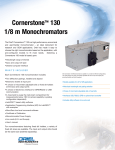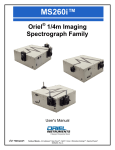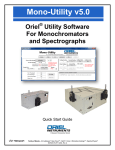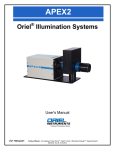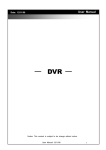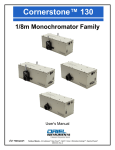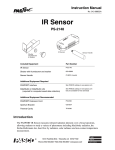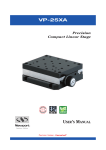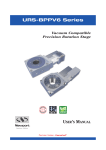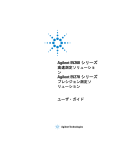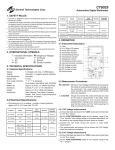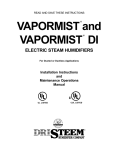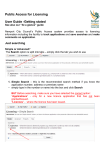Download Oriel Cornerstone 260 Datasheet
Transcript
Cornerstone™ 260 1/4 m Monochromators The Oriel® Cornerstone™ 260 is a high performance, economical and user-friendly monochromator – an ideal instrument for research and OEM applications. Oriel has made it easy to choose the right monochromator based on the application, with pre-configured models to fit most needs. Selecting a Cornerstone 260 model is based upon: • Wavelength range of interest • Input and output slit type • Single or dual output port • Desired computer interface W H AT ' S I N C L U D E D Each Cornerstone 260 monochromator includes: The Cornerstone 260 Monochromator is available in a number of different configurations. The model shown here uses micrometer adjustable slits at the input and output port, providing flexibility and high throughput. • Preselected diffraction gratings, installed and aligned • Electronic shutter at input port • Models available for UV to NIR applications • A choice of single or dual output ports • A choice of micrometer adjustable slits, motorized or fixed slit holders at the input port and output port(s) • A choice of electronics interface for GPIB/RS232 or USB communication • Motorized wavelength and grating selection • Choice of micrometer adjustable slits, motorized slits or fixed slits • A hose barb to purge the instrument compartment for measurements below 180 nm (actual capability is grating configuration dependent) • Single or dual output port instruments available • LabVIEW™ based utility software • Interfaces USB, RS232, GPIB or optional hand controller • Application Programming Interface (API) for LabVIEW™ with examples • Includes utility software at no extra cost • MonoTerm low-level command software • Certificate of Calibration • Monochromator Power Supply • Line cords (U.S. and Europe) • User’s manual For monochromators featuring fixed slit holders, a variety of fixed slit sizes are available. The input and output slits should be the same size (ordered separately). CORNERSTONE 260 1 / 4 M M O N O C H R O M A T O R S T R AY L I G H T R E J E C T I O N Stray light may have a variety of origins. Its presence may be caused by a wide variety of design and manufacturing factors. The level of stray light due to the dispersed radiation inside the monochromator is affected by the design of the instrument, its baffles and interior finish. The Cornerstone 260 incorporates a sophisticated design, proven materials, and a quality manufacturing system to ensure high stray light rejection. OPTICAL DESIGN The optical design of the Cornerstone 260 is based upon an asymmetrical in-plane version of a Czerny-Turner monochromator. The optical configuration is designed to ensure high resolution and maximum throughput. This F/3.9 monochromator is optimized to provide excellent stray light rejection while minimizing aberrations. A high precision motor is used to select the desired wavelength and switch between diffraction gratings quickly, without sacrificing performance. ENTRANCE The amount of stray light measured on top of true signal will depend on many experimental factors as well as the performance of the instrument. When comparing stray light specifications, it is important to compare values that were measured under identical circumstances. The spectral distribution of the source and the response of the detection system are often the dominant factors when determining a stray light value. G R AT I N G S The choice of gratings for any spectroscopic system depends on the application and must be made as one step in an iterative process of system design. The radiation source, radiation detector, polarization of radiation, spectral range of interest and desired resolution all play a role in grating selection. Two or three gratings are installed into the Cornerstone 260 monochromator. In general, the grating with the highest efficiency is chosen at a particular wavelength. The optional Oriel TracQ Basic Data Acquisition and Radiometery Software allows users to set up a specific grating switchover wavelength, so the most appropriate grating will automatically be chosen while performing a scan over a range of wavelengths. LATERAL EXIT AXIAL EXIT OPTIONAL OUTPUT MIRROR Optical configuration of the Cornerstone 260 Monochromator. The instrument may be configured with either two or three diffraction gratings. The Cornerstone 260 monochromators feature diffraction gratings produced by Richardson Gratings. Both Oriel Instruments and Richardson Gratings are part of the Newport family of brands, and have a long history of working together to design monochromators that are appropriate for a wide variety of applications. Configuration Grating 1 Line Density Grating 2 Line Density Grating 3 Line Density Primary Wavelength Range High Resolution 1200 lines/mm 1200 lines/mm 1200 lines/mm 200 to 1350 nm High Resolution Extended Range 1200 lines/mm 1200 lines/mm 600 lines/mm 300 to 1800 nm UV-VIS 600 lines/mm 600 lines/mm n/a 200 to 1300 nm Extended Range 600 lines/mm 600 lines/mm n/a 250 to 2400 nm Near Infrared 600 lines/mm 300 lines/mm n/a 550 to 2500 nm CORNERSTONE 260 1 / 4 M M O N O C H R O M A T O R Grating Efficiency Curves Grating Efficiency Curves Cornerstone™ 260 Monochromator Extended Range Configuration Cornerstone™ 260 Monochromator High Resolution Configuration 100 100 90 80 70 — Grating 1 — Grating 2 — Grating 3 Efficiency (%) Efficiency (%) 90 80 70 60 50 40 30 20 10 0 — Grating 1 — Grating 2 60 50 40 30 20 10 200 400 600 800 1000 1200 0 1400 Wavelength (nm) 200 400 600 800 1000 The efficiency curve above is relative (not absolute) and was measured using an in-plane near Littrow configuration. Please use the curves as a guide and not as absolute data. Grating diffraction is dependent on the polarization of the radiation incident on the grating. 1600 1800 2000 2200 2400 Grating Efficiency Curves Grating Efficiency Curves Cornerstone™ 260 Monochromator High Resolution Extended Range Configuration 100 100 90 80 70 — Grating 1 — Grating 2 Efficiency (%) Efficiency (%) 1400 The efficiency curve above is relative (not absolute) and was measured using an in-plane near Littrow configuration. Please use the curves as a guide and not as absolute data. Grating diffraction is dependent on the polarization of the radiation incident on the grating. Cornerstone™ 260 Monochromator UV-VIS Configuration 60 50 40 30 20 10 0 1200 Wavelength (nm) 90 80 70 — Grating 1 — Grating 2 — Grating 3 60 50 40 30 20 10 200 400 600 800 1000 1200 0 1400 300 600 900 Wavelength (nm) 1200 1500 1800 Wavelength (nm) The efficiency curve above is relative (not absolute) and was measured using an in-plane near Littrow configuration. Please use the curves as a guide and not as absolute data. Grating diffraction is dependent on the polarization of the radiation incident on the grating. The efficiency curve above is relative (not absolute) and was measured using an in-plane near Littrow configuration. Please use the curves as a guide and not as absolute data. Grating diffraction is dependent on the polarization of the radiation incident on the grating. Grating Efficiency Curves SLITS Cornerstone™ 260 Monochromator VIS-NIR Configuration 100 The resolution of the monochromator is related to the grating dispersion – a function of the grating design – and the slit width. Resolution at the blaze wavelength of the grating is calculated to be the reciprocal dispersion multiplied by the slit width. — Grating 1 — Grating 2 90 80 70 Efficiency (%) To operate any monochromator, slits are required at the input and output port. These need to be the same width and height at all ports. The slits offered with the Cornerstone 260 all have 1.5-inch male flanges, allowing them to be easily connected to the wide variety of Oriel accessories and instruments. 60 50 40 30 20 10 0 400 600 800 1000 1200 1400 1600 1800 2000 Width Height 77222 10 mm 2 mm 77220 25 mm 3 mm Available configurations: 77219 50 mm 6 mm 77218 120 mm 18 mm* • Fixed slit holders (fixed slits sold separately) 77217 280 mm 18 mm* • Micrometer adjustable slits 77216 600 mm 18 mm* 77215 760 mm 18 mm* 77214 1.24 mm 18 mm* 77213 1.56 mm 18 mm* 77212 3.16 mm 18 mm* 77211 6.32 mm 18 mm* The fixed slits slide into the holders at the input and output port. The width and height cannot be adjusted, but may be individually replaced with other slit sizes. Fixed slits are a low cost alternative with excellent repeatability. They are a good choice when only a few slit sizes are required. They are sold separately to allow customized choices based on the needs of the application. When ordering, be sure to purchase fixed slits of the same model for the input port and output port(s). Order two fixed slits for single output models, and three fixed slits for the dual output port monochromators. 2400 26 The efficiency curve above is relative (not absolute) and was measured using an in-plane near Littrow configuration. Please use the curves as a guide and not as absolute data. Grating diffraction is dependent on the polarization of the radiation incident on the grating. Fixed Slit Model • Motorized slits with dual output port instruments 2200 Wavelength (nm) *Actual slit height is 18 mm, usable height is 12 mm. Fixed slit holder without the slit installed. Fixed slit holder with a slit installed (slits ordered separately). CORNERSTONE 260 A micrometer adjustable slit assembly is continously variable from fully closed to 3 mm width. The narrowest practically achievable width is 4 mm. A height adjustment slide allows variation in the height from 2 to 12 mm. Benefits of the micrometer adjustable slits are flexibility and high throughput. Please note that optimum spectral resolution for any monochromator is obtained with short, narrow slits. This type of slit is designed primarily for versatility and convenience in changing resolution and throughput; fixed slits should be used for the utmost accuracy and repeatability, especially at high resolution. Micrometer adjustable slit assembly. The slide shown on the right is used to adjust the height and the micrometer adjusts the width of the slit. Note that the input and output slits should be set to the same width and height. A motorized slit assembly may be adjusted from 6 mm to 2 mm width in 6 mm steps. The slit width is controlled through the utility software, optional hand controller, optional TracQ Basic software or by using low level commands. An advantage of using motorized slits is that in addition to setting the slit widths individually, the software can be configured to an automatic bandpass setting. The software adjusts the slit widths to maintain the chosen bandpass as scans are performed using multiple gratings and either output port. Motorized slits are available with dual output port Cornerstone 260 monochromators. Motorized slits. SINGLE OR DUAL OUTPUT PORTS The Cornerstone 260 is available with a single output port or dual output ports. A single output port is the most economical choice, and the simplest arrangement when using a single detector. If more than one detector is required for the 1 / 4 M M O N O C H R O M A T O R application, the use of a single output port instrument results in the experiment needing to be stopped to switch detectors. An alternative is to use a beamsplitter after the output port, which results in lower power reaching the two detectors. In this situation, a dual output port monochromator may be a better choice. Two output ports allow continuous scanning over a broad wavelength range without needing to break down the setup to swap detectors. An flip mirror inside the monochromator is used to select the output port. This mirror is controlled through the monochromator software, low level commands or the optional hand controller. Please note that with dual output port instruments, an unused port left uncoupled can become a source of stray light entering into the monochromator. By using the Oriel's Model 77765 Motorized Beam Steerer, the Cornerstone 260 can be transformed into a dual input monochromator. With the Motorized Beam Steerer installed before the monochromator's input port, there is no need to break down the setup to install, align and warm up a second light source. One of two different light sources may be selected with the flip of a switch. SOFTWARE INTERFACES LabVIEW-based utility software is included at no extra cost with all Cornerstone models to control both the monochromator and filter wheel accessory. The utility software provided with the monochromator includes USB drivers for Windows 7 32-bit and 64-bit operating systems. The software can also control the instrument through an RS232 or GPIB connection. Oriel’s optional TracQ Basic Data Acquisition and Radiometery Software is an instrument control package that includes data acquisition and processing. TracQ Basic allows users to acquire spectroscopic measurement data quickly and easily, without requiring any programming knowledge. TracQ Basic is true radiometry software, which enables users to acquire basic voltage measurements or use the built-in algorithms for spectroscopic measurements. Data acquisition and processing occurs in real time. TracQ Basic is an application integrating Oriel monochromators with various detection instruments, such as the Newport Optical Power and Energy Meters, 1936-R and 2936-R , 1918-R and LIDA-SRS-KIT. Software prompts guide users through the measurement process. Instruments are controlled and scan parameters are set up through simple, intuitive dialog boxes. The front panel of the software allows one to see instrument status, present wavelength, signal reading and the selected wavelength units. CORNERSTONE 260 1 / 4 M M O N O C H R O M A T O R An intuitive command set is provided for those wishing to create their own programming. A list of these commands is provided in the user’s manual included with the monochromator. Commands are simple to use. For example, to query the wavelength, enter “WAVE?” The command to close the shutter is “SHUTTER C”. For those users who are developing their own LabVIEW™ based programs, an Application Programming Interface (API) document is included with the instrument. The Oriel MonoTERM utility is also provided for sending low-level commands to the monochromator. This is very convenient for assisting programmers in their software development efforts. The MonoTERM utility was developed in National Instruments LabVIEW. It's open source code, so it may be used to provide LabVIEW programming examples. C O M M U N I C AT I O N M E T H O D S Models are available with the following computer interfaces: • RS232 and GPIB • USB 2.0 The utility software provided with the monochromator includes USB drivers for Windows 7 32-bit and 64-bit operating systems. A legacy version of the utility software is available for Windows XP upon request. GPIB communication offers the distinct advantage of being able to connect multiple devices to a single GPIB port, provided the computer contains a GPIB adapter card. Both GPIB and RS232 communication methods simplify low-level communications, as there is no driver or dll file. Cornerstone 260 USB models include a USB 2.0 A/B cable (Model 70044). For RS232/GPIB monochromators, cable 70040 (RS232) or 70038 (GPIB) may be ordered separately. For those who desire the simplicity of GPIB or RS232 communication but have only USB ports available, a number of GPIB/USB and RS232/USB converter cables are commercially available. All models include a connector to utilize the optional Model 74009 Hand Controller. With this item, there is no need to install software or use a computer. This dedicated interface is designed specifically for use with Oriel’s Cornerstone series monochromators. There is no need to memorize commands or key sequences. The 24 keys are clearly labeled with functions like “Shutter”, “Go Wave” and “Filter”. The backlit LCD display provides information on the grating selection, line density, active filter position, current wavelength and shutter status. Using the Hand Controller is intuitive and provides access to nearly all the functionality of the Cornerstone. The Model 74009 optional hand controller is compatible with all Cornerstone 260 monochromators. M O T O R I Z E D F I LT E R W H E E L ACCESSORY CONTROL The Cornerstone 260 is capable of automatically controlling an optional filter wheel, Model 74010. It is also able to interface with the motorized filter wheel included with Oriel’s APEX2 light sources. These filter wheels hold up to six 1-inch [25.4 mm] diameter filters. Neutral density filters can be used for intensity adjustment. Order sorting filters may be installed to block higher order diffraction. The filter wheel can be mounted to the male flanges of the monochromator slits or slit holders. The filters are mounted external to the monochromator. Thus, the refractive index and thickness of the filters do not significantly affect the focal distance to the collimating mirror inside the monochromator. With internal filters, this distance would be different for every wavelength and every filter, and would therefore adversely affect resolution. The Cornerstone 260 is designed and manufactured to have errors of only a fraction of a millimeter in the focal distance. Positioning the filters externally, usually before the input slit, has only a slight effect on the light throughput. Since the slit acts as a secondary source, the focal distance is not affected. CORNERSTONE 260 1 / 4 Mounting plates are available to fasten the Cornerstone 260 to an optical table, and to couple with Oriel’s popular Research Lamp Housings and APEX2 light sources. Threaded holes on the mounting surface also allow rod mounting of the monochromator, if desired. The 74105 Mounting Plate is used to secure a Cornerstone 260 Monochromator to an inch or metric optical table. The ability to mount the monochromator simplifies setup and alignment of the optical system. The mounting plate also helps ensure consistent results over time, as the monochromator cannot be accidentally moved out of position. The plate adds 0.25 inch [6.35 mm] to the optical height. Specification M M O N O C H R O M A T O R The 74104 Mounting Kit connects the Cornerstone 260 monochromator to an arc lamp or quartz tungsten halogen light source. This kit is compatible with Oriel's Research Lamp Housings which hold lamps rated from 50W to 250W. The mounting kit includes a base plate, a flexible light shield, a 1.5-inch diameter focusing lens and lens holder. All the hardware required to mount the lamp housing and monochromator to the base plate is provided. The mounting kit's base plate comes with four adjustable leveling feet. The feet may be removed to secure the base plate to an inch or metric optical table. Micrometer Adjustable Slit Specifications Focal Length 260 Width Range 4 mm to 3 mm F/# F/3.9 Height Range 3 to 12 mm Wavelength Drive Motorized Repeatability ±10 mm Usable Wavelength Range 180 to 2500 nm, grating dependent Accuracy Spectral Resolution Grating dispersion and slit width dependent ±10 mm (width from 4 mm to 250 mm) ±5% (width from 250 mm to 3 mm) Wavelength Accuracy 0.35 nm Wavelength Precision 0.08 nm Maximum Slew Rate 205 nm/s with 1200 line/mm grating Stray Light 0.03% Motorized Slit Specifications External Shutter Control BNC connector (Normally closed shutter opens when BNC is shorted) Width Range 6 mm to 2 mm, in 6 mm increments Height 15 mm Input Ports Output Ports 1 input port, expandable to two input sources using optional 77765 Beam Steerer Axial (all models) and Lateral (dual port models) Shutter minimum exposure time 0.2 s Shutter maximum repetition rate 0.5 Hz Motorized Filter Wheel Compatibility Filter Wheel Model 74010, Apex2 Filter Wheel Utility Software Requirements Windows 7 32-bit or 64-bit operating system (Windows XP compatible software also available) TracQ Basic Software Compatible Yes 74009 Hand Controller Compatible Yes Power Requirements 100-240 VAC, 47-63 Hz Weight 21 lb [9.5 kg] Repeatability ±5 mm Accuracy ±10 mm Wavelength Accuracy: the capability of the monochromator to output the desired wavelength. Wavelength Precision: the ability of a wavelength to be consistently reproduced and the number of significant digits to which it has been reliably measured. Grating Properties Configuration High Resolution High Resolution Extended Range UV-VIS Extended Range VIS-NIR Grating Position Type Groove Density (lines/mm) Blaze Wavelength (nm) Reciprocal Dispersion (nm/mm) #1 Holographic 1200 250 3.2 #2 Ruled 1200 350 3.2 #3 Ruled 1200 1000 3.2 #1 Ruled 1200 350 3.2 #2 Ruled 1200 750 3.1 #3 Ruled 600 1000 6.4 #1 Ruled 600 200 6.4 #2 Ruled 600 400 6.5 #1 Ruled 600 400 6.5 #2 Ruled 600 1000 6.4 #1 Ruled 600 1000 6.4 #2 Ruled 300 2000 12.9 CORNERSTONE 260 1 / 4 M M O N O C H R O M A T O R Slit Width vs. Resolution All monochromators featuring fixed slit holders require fixed slits to be installed at the input and output ports. Fixed slits are ordered separately, and should be the same size at the input and output ports. Micrometers adjustable slits allow for continuous variation of the width and height and motorized slits may be adjusted in 6 mm increments. Use the table below for guidance on resolution vs. slit width. For slit widths not specified in the table, multiply the micrometer adjustable slit width setting (mm) by the reciprocal disperion (nm/mm) to calculate the resolution for each grating. Resolution is calculated for each grating at the grating's blaze wavelength, i.e. the wavelength with the greatest efficiency. Actual performance is determined by the monochromator wavelength accuracy, precision and calibration. Newport suggests having the monochromator recalibrated annually by a qualified service technician. Calculation of Resolution Based on Fixed Slit Selection Grating Grating 2 3 Fixed Slit Slit Width Grating 1 Grating 1 77222 10 mm* 0.03 nm 0.25 nm** 0.03 nm 0.03 nm 0.25 nm** 0.06 nm 77220 25 mm* 0.08 nm 0.25 nm** 0.08 nm 0.08 nm 0.25 nm** 0.16 nm 77219 50 mm* 0.16 nm 0.35 nm** 0.16 nm 0.16 nm 0.35 nm** 0.32 nm 77218 120 mm* 0.38 nm 0.50 nm** 0.38 nm 0.38 nm 0.50 nm** 0.77 nm 77217 280 mm 0.90 nm 0.90 nm 0.90 nm 0.90 nm 0.90 nm 1.8 nm 77216 600 mm 1.9 nm 1.9 nm 1.9 nm 1.9 nm 1.9 nm 3.8 nm 77215 760 mm 2.4 nm 2.4 nm 2.4 nm 2.4 nm 2.4 nm 4.9 nm 77214 1.24 mm 4.0 nm 4.0 nm 4.0 nm 4.0 nm 4.0 nm 7.9 nm 77213 1.56 mm 5.0 nm 5.0 nm 5.0 nm 5.0 nm 5.0 nm 10 nm 77212 3.16 mm 10 nm 10 nm 10 nm 10 nm 10 nm 20 nm 77211 6.32 mm 20 nm 20 nm 20 nm 20 nm 20 nm 40 nm Fixed Slit Slit Width Grating 1 Grating 2 Grating 1 Grating 2 77222 10 mm* 0.06 nm 0.07 nm 0.07 nm 0.06 nm 0.06 nm 0.13 nm 77220 25 mm* 0.16 nm 0.16 nm 0.16 nm 0.16 nm 0.16 nm 0.32 nm 77219 50 mm* 0.32 nm 0.33 nm 0.33 nm 0.32 nm 0.32 nm 0.65 nm 77218 120 mm* 0.77 nm 0.78 nm 0.78 nm 0.77 nm 0.77 nm 1.55 nm 77217 280 mm 1.8 nm 1.8 nm 1.8 nm 1.8 nm 1.8 nm 3.61 nm 77216 600 mm 3.8 nm 3.9 nm 3.9 nm 3.8 nm 3.8 nm 7.74 nm 77215 760 mm 4.9 nm 4.9 nm 4.9 nm 4.9 nm 4.9 nm 9.80 nm 77214 1.24 mm 7.9 nm 8.1 nm 8.1 nm 7.9 nm 7.9 nm 16 nm 77213 1.56 mm 10 nm 10 nm 10 nm 10 nm 10 nm 20 nm 77212 3.16 mm 20 nm 21 nm 21 nm 20 nm 20 nm 41 nm 77211 6.32 mm 40 nm 41 nm 41 nm 40 nm 40 nm 82 nm High Resoultion Configuration Grating 3 High Resoultion Extended Range Configuration Calculation of Resolution Based on Fixed Slit Selection Grating Grating 2 1 UV-VIS Configuration Grating 2 Extended Range Configuration VIS-NIR Configuration * For slits with widths of 120 mm or less, abberations begin to play a role in the actual achievable resolution. The values noted above, unless otherwise stated, are calculations based on the slit widths and grating dispersions. ** Empirically measured resolution values shown at 546.1 nm, which differ from calculations due to abberations present when using narrow slit widths. 1.5 INCH SERIES MALE FLANGE (INPUT PORT) 11.0 11.75 (279.4) (298.5) 1.5 INCH SERIES MALE FLANGES 1.57 (40) 5.38 (136.6) LATERAL OUTPUT PORT (DUAL OUTPUT MODELS ONLY) INPUT PORT 3.52 1/ 4m (89.4) 6.70° 2.38 (60.4) 14.25 (362) .39 (10) 6.38 (162) 13.63 (346) 6.70° FOCAL PLANES AXIAL OUTPUT PORT CORNERSTONE 260 1 / 4 M M O N O C H R O M A T O R Ordering Information Cornerstone 260 Monochromators (USB Models) Model High High Resolution Resolution Extended Range UV-VIS Extended Range VIS-NIR Fixed Slit Holders Micrometer Slits CS260-USB-1-FH-A • • CS260-USB-1-FH-D • • CS260-USB-1-MC-A • • CS260-USB-1-MC-D • • CS260-USB-1-MT-D • Motorized Slits Single Output Port • • • • • CS260-USB-Q-FH-A • CS260-USB-Q-MC-A • • • • • CS260-USB-2-FH-A • • CS260-USB-2-FH-D • • CS260-USB-2-MC-A • • CS260-USB-2-MC-D • • CS260-USB-2-MT-D • • • • • • • CS260-USB-3-FH-D • • CS260-USB-3-MC-A • • CS260-USB-3-MC-D • • CS260-USB-3-MT-D • • • • • • • CS260-USB-4-FH-D • • CS260-USB-4-MC-A • • CS260-USB-4-MC-D • • CS260-USB-4-MT-D • Extended Range • • CS260-USB-4-FH-A UV-VIS • • CS260-USB-3-FH-A Cornerstone 260 Monochromators (RS232/GPIB Models) Model High High Resolution Resolution Extended Range VIS-NIR • • • • • • Fixed Slit Holders Micrometer Slits CS260-RG-1-FH-A • • CS260-RG-1-FH-D • • CS260-RG-1-MC-A • • CS260-RG-1-MC-D • • CS260-RG-1-MT-D • Motorized Slits • Single Output Port • CS260-RG-Q-MC-A • • • • • • • • CS260-RG-2-FH-A • • CS260-RG-2-FH-D • • CS260-RG-2-MC-A • • CS260-RG-2-MC-D • • CS260-RG-2-MT-D • • • • • • • CS260-RG-3-FH-A • • CS260-RG-3-FH-D • • CS260-RG-3-MC-A • • CS260-RG-3-MC-D • • CS260-RG-3-MT-D • • • • • • • CS260-RG-4-FH-A • • CS260-RG-4-FH-D • • CS260-RG-4-MC-A • • CS260-RG-4-MC-D • • CS260-RG-4-MT-D • • • • • • • Newport Corporation, Global Headquarters 1791 Deere Avenue, Irvine, CA 92606, USA PHONE: 1-800-222-6440 1-949-863-3144 Dual Output Ports • • CS260-RG-Q-FH-A Dual Output Ports FAX: 1-949-253-1680 • www.newport.com EMAIL: [email protected] Complete listings for all global office locations are available online at www.newport.com/contact Newport Corporation, Irvine, California and Franklin, Massachusetts; Evry and Beaune-la-Rolande, France and Wuxi, China have all been certified compliant with ISO 9001 by the British Standards Institution. Santa Clara, California is DNV certified. DS-121401








